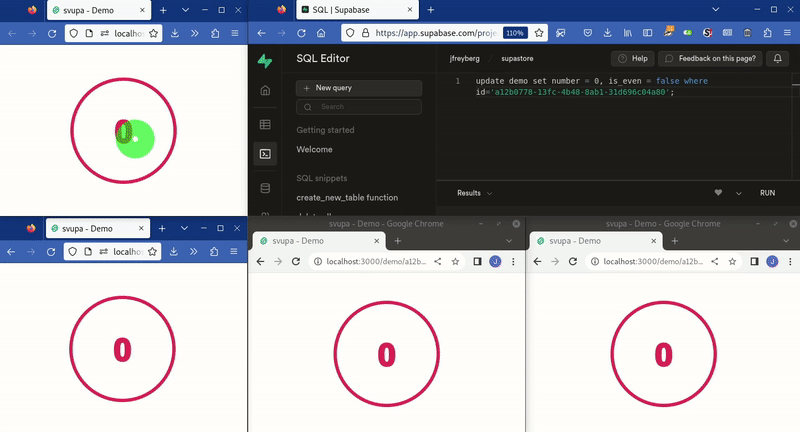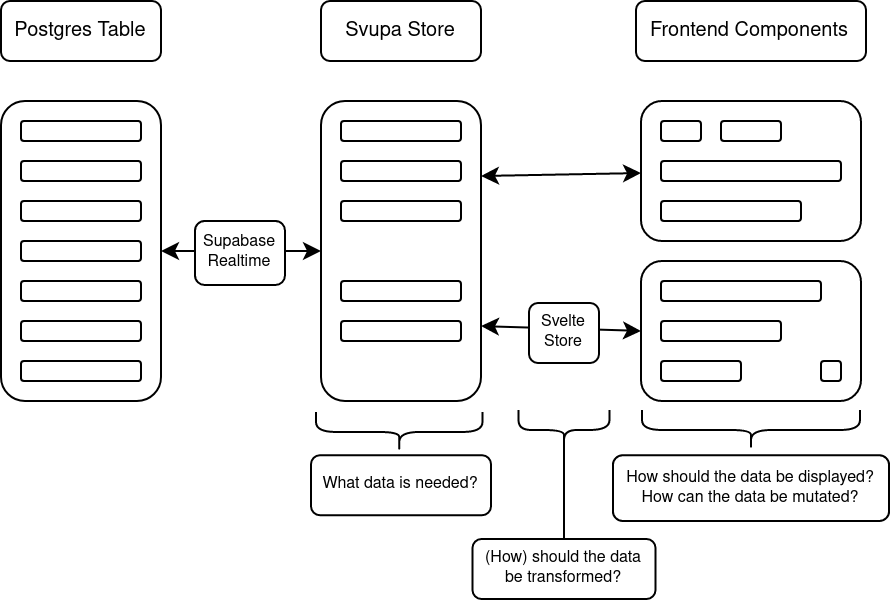3 |  4 |
4 |
11 | 12 | Supabase is an open-source database built on top of PostgreSQL. Svupa synchronizes (part of) the data from this database directly into a Svelte store. Since multiple users can subscribe to the same data, all clients will see the same state. With Svupa, it's as easy to react to changes in your database as it is to react to changes in a Svelte store - and that's damn easy. 13 | 14 | 15 | If you're still confused, don't worry! You can see an example right here: 16 | 17 |

18 | And a conceptual overview here: 19 |
20 |

21 | 22 | I also provide much more information on the project website, including a live demo. 23 | 24 | Why Supabase?
25 | 26 | Supabase and Svelte are an excellent fit because they are built on similar paradigms, are rapidly gaining popularity, and focus on developer experience. Svupa seamlessly combines the two to create a framework that enables developers to build realtime applications much faster and without headaches. 27 | 28 | Project Status and Submission to SvelteHack
29 | 30 | Currently, Svupa is in a proof-of-concept state. My submission is not a fully functional framework but a demo of what Svupa can achieve, which is presented on the demo website I am submitting. I plan to release Svupa as a framework in the future, but that is way beyond the scope of the two months intended for this hackathon, even if I were working full-time on this. Maybe this hackaton helps me find some contributors. Of course, I will not touch the repository after the deadline until the winners are announced, or switch to another repo if that is prefered by Svelte Society. Considering that there are multi-million-dollar-backed startups developing solutions that achieve things similar to Svupa, e.g., Convex, I consider my submission a worthy contribution to the open-source community and a proper example of how Svelte can be integrated with other web technologies to create cool things. 31 | -------------------------------------------------------------------------------- /docker-compose.yml: -------------------------------------------------------------------------------- 1 | version: '3' 2 | 3 | services: 4 | webapp: 5 | build: 6 | context: . 7 | container_name: svupa-webapp 8 | volumes: 9 | - type: bind 10 | source: ./src 11 | target: /app/src 12 | - type: bind 13 | source: ./static 14 | target: /app/static 15 | ports: 16 | - 127.0.0.1:3000:3000 -------------------------------------------------------------------------------- /header.png: -------------------------------------------------------------------------------- https://raw.githubusercontent.com/jfreyberg/svupa/d501e5f470cf26bb1a3d0847adaad2f32f5b1d54/header.png -------------------------------------------------------------------------------- /jsconfig.json: -------------------------------------------------------------------------------- 1 | { 2 | "extends": "./.svelte-kit/tsconfig.json", 3 | "compilerOptions": { 4 | "baseUrl": ".", 5 | "paths": { 6 | "$lib": ["src/api"], 7 | "$lib/*": ["src/api/*"] 8 | } 9 | }, 10 | "include": ["src/**/*.d.ts", "src/**/*.js", "src/**/*.svelte", "src/utils/svupa.ts"] 11 | } -------------------------------------------------------------------------------- /package.json: -------------------------------------------------------------------------------- 1 | { 2 | "name": "svupa", 3 | "version": "0.0.1", 4 | "type": "module", 5 | "license": "MIT", 6 | "files": [ 7 | "dist" 8 | ], 9 | "scripts": { 10 | "build:tailwind": "npx postcss static/tail.css -o static/styles.css", 11 | "dev": "vite dev --host", 12 | "prod": "npm run build && ls && ls ./build && node build/index.js", 13 | "build": "vite build", 14 | "package": "svelte-kit package", 15 | "preview": "svelte-kit preview" 16 | }, 17 | "dependencies": { 18 | "@sveltejs/package": "^2.2.4" 19 | }, 20 | "devDependencies": { 21 | "@supabase/supabase-js": "2.39.1", 22 | "@sveltejs/adapter-vercel": "next", 23 | "@sveltejs/kit": ">=1.15.2", 24 | "svelte": "3.58.0", 25 | "svelte-highlight": "7.2.0", 26 | "svelte-preprocess": "^4.10.4", 27 | "tailwindcss": "^3.2.7", 28 | "uuid": "9.0.0", 29 | "vite": "^4.0.0", 30 | "typescript": "^4.3.3" 31 | }, 32 | "exports": { 33 | ".": { 34 | "types": "./dist/index.d.ts", 35 | "svelte": "./dist/index.js" 36 | } 37 | } 38 | } 39 | -------------------------------------------------------------------------------- /src/app.html: -------------------------------------------------------------------------------- 1 | 2 | 3 | 4 | 5 | 6 | 7 | 8 | 9 | 10 |
 46 |
46 |  30 | {#if text && text.length > 0}
31 |
36 | {/if}
37 |
30 | {#if text && text.length > 0}
31 |
36 | {/if}
37 |  52 |
52 |  65 |
65 |  {
150 | deleteRow(row.id);
151 | }}
152 | />
153 |
154 |
155 |
{
150 | deleteRow(row.id);
151 | }}
152 | />
153 |
154 |
155 |  {
159 | upsertRow(row.id);
160 | }}
161 | />
162 |
{
159 | upsertRow(row.id);
160 | }}
161 | />
162 |  10 |
10 |  {text}
7 |
{text}
7 |
7 |
9 | The total value of number_field is {$sum}.
\n", 4 | "sql": "INSERT INTO table_name (primary_key, my_column, another_column) VALUES ('key-123', 'my_value', 'new data');", 5 | "installNpm": "npm install svupa --save", 6 | "installYarn": "yarn install svupa ?" 7 | } -------------------------------------------------------------------------------- /src/global.d.ts: -------------------------------------------------------------------------------- 1 | ///16 | Hey there 👋 If you like Svupa.js consider dropping a star on { 18 | openInNewTab("https://github.com/jfreyberg/Svupa"); 19 | }} 20 | class="underline cursor-pointer">Github! 22 |
23 | {
27 | header_open = false;
28 | }}
29 | />
30 |
{
27 | header_open = false;
28 | }}
29 | />
30 |  85 |
85 |  107 |
107 | Share this very demo.
171 | 172 |175 | You can open this link in a new tab, another browser, your phone or send it 176 | to your friend on another continent. They will see the same data as you do, 177 | and they will see it update in realtime when you click - and you will see 178 | their changes in realtime too. 179 |
180 | 181 |Imagine a more complex scenario.
182 | 183 |184 | This is just a minimalistic demo. You are viewing and manipulating one single value 187 | in one isolated row in 188 | one lonely table. But Svupa will work just as 189 | fine with dozens of tables, 190 | hundreds of rows 191 | and thousands of values. If synchronization of 192 | one single integer already looks that cool, imagine what synchronization of 193 | a whole application can look like. Sounds like a you need to write a lot of 194 | code, doesn't it? Fortunately, it is svupa simple. 195 |
196 | 197 |202 | Using the Supabase API is low effort already. Svupa takes it to the next 203 | level. You can integrate it into your existing Svelte project with just a 204 | few lines of code. 205 |
206 | 207 |
224 | That's it. Your application is now subscribed to the state of
225 |
234 | Svupa has some built in metadata stores like
249 | And - you probably already guessed it - this store and the dependent UI 250 | components are updated with any update to the underlying data. No matter if 251 | it's an optimistic update or an update in the database, your UI will always 252 | be up to date and consistent. 253 |
254 | 255 |258 | Updates of relevant rows will trigger a render of the component on all 259 | subscribed clients, no matter where they come from. Any microservice or 260 | cronjob can update the data and all clients will immediately see the change. 261 |
262 |280 | Currently, Svupa is in a proof of concept state and I am very happy about 281 | feedback. The framework is in open alpha (i.e. it works and is openly 282 | available on GitHub), but there is no npm release yet. While the majority of 283 | features seem to be running stable, it is strongly advised against using 284 | Svupa for anything other than playing around as of now and the API is very 285 | likely going to change (improve) drastically before the first beta release. 286 | If you have questions, ideas or feedback, please get in touch. 287 |
288 | 289 |8 | This website does not use cookies and it does not collect any personal data. 9 |
10 | 11 |14 | Mühlingstraße 1A
15 | 69121 Heidelberg 16 |
13 | I built Svupa to use it at my startup kmapp.io. We are building a modern, document-centric knowledge management platform. 17 | Building a multi-user web app is not easy, there are a lot of things to 18 | consider during development. One of the most important things is the state 19 | of the application. The state of the application is what the user sees, and 20 | ideally, it should be consistent for all users that are currently viewing 21 | the same content. If user A adds a comment, user B should see this comment 22 | in realtime. It is absolutely possible to achieve this with Supabase and 23 | Svelte, but doing it for many different parts of the application (comments, 24 | tags, etc.) requires a lot of boilerplate code. Abstraction is the key to 25 | success here, and that is when I came up with the idea for Svupa - an 26 | abstraction layer, that makes it easy to build realtime web apps. 27 |
28 | 72 | 75 |
76 |
75 |
76 | 77 | As a developer, one just just needs to define what data is needed, if (and 78 | how) it needs to be transformed and how the data should be displayed to the 79 | user and mutated by the user. Everything else is handled by Svupa. The data 80 | changes, the UI updates. 81 |
82 | 83 |87 | Svupa is built on top of Svelte and Supabase, which in turn is built on top 88 | of Postgres. This makes Svupa a heavily opinionated framework. Below you 89 | will see why I chose these dependencies, as well as explanations of how to 90 | understand Svupa if you are not familiar with Svelte or Supabase. 91 |
92 |94 | If you are familiar with Svelte (especially stores and reactivity) you can 95 | think of Svupa like this: Using a Svelte store means you can see changes 96 | applied to the store data immediately on the UI. With Svupa, the same thing 97 | happens but not just for one user, but all users who subscribe to a the data 98 | of a store. 99 |
100 | 101 |Why Svelte?
105 |117 | If you are familar with Supabase Realtime, you can think of Svupa like this: 118 | Using realtime, changes in your database are streamed to subscribed 119 | instances of your application (client browsers). Svupa now leverages Svelte 120 | to further "stream" this data inside the clients browser, transforming it if 121 | necessary and updating the UI to instantly reflect your changes. 122 |
123 |Why Supabase?
127 |142 | There are other great, much more sophisticated and established frameworks 143 | that deal with client synchronization. If you like Svupa, check out these 144 | frameworks to see if they fit your usecase. 145 |
146 | 15 |
15 |  212 |
212 |